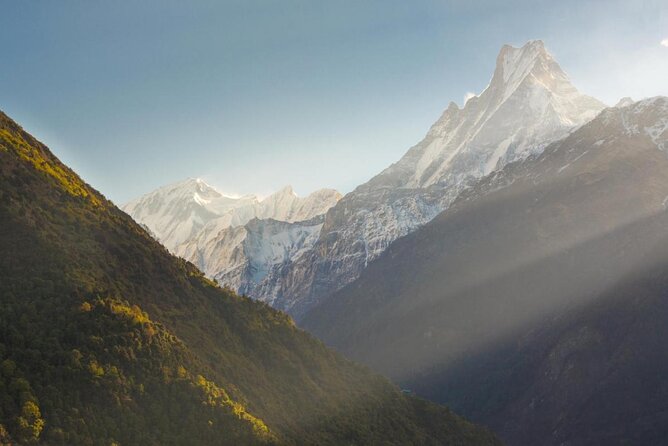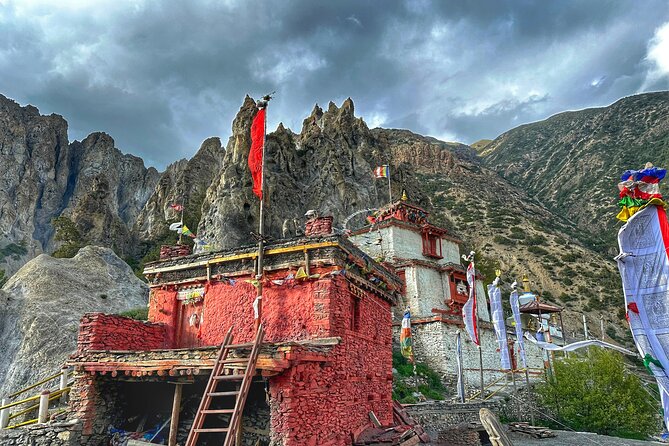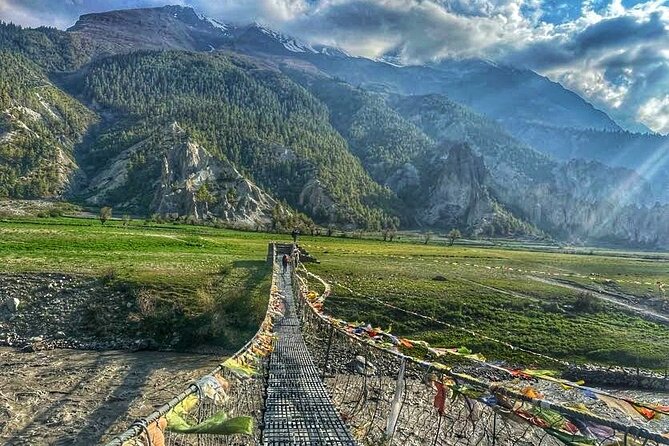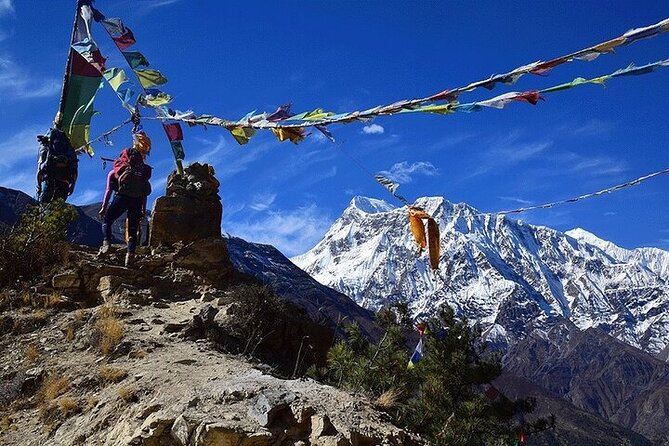Annapurna Circuit Trek
Nestled amidst the towering peaks like a hidden gem, the Annapurna Circuit Trek beckons adventurers with promises of unparalleled beauty and culture.
As the trail winds through diverse landscapes, from lush valleys to rugged mountain passes, each step unveils a new chapter in this epic journey.
But what challenges lie ahead for those who dare to tread this iconic path? What tales of triumph and camaraderie await amidst the Himalayan grandeur?
Join this discussion to uncover the secrets of the Annapurna Circuit Trek and discover why this expedition captures the hearts of trekkers worldwide.
Key Points

- Altitude acclimatization is crucial for Annapurna Circuit Trek due to significant elevation gain.
- Proper gear preparation for changing weather conditions is essential for safety and comfort.
- Choose accommodation wisely between luxury lodges and camping sites for a tailored experience.
- Fitness preparation, hydration, and energy snacks are vital for a successful trekking journey.
Trek Overview
Embark on the iconic Annapurna Circuit Trek, a breathtaking journey through the heart of the Himalayas, offering unparalleled vistas and culture.
Altitude acclimatization is crucial on this trek due to the significant elevation gain, starting from around 2,700 feet and reaching heights of over 17,000 feet. It’s essential to ascend gradually to allow the body to adjust to the decreasing oxygen levels.
Weather conditions along the Annapurna Circuit vary based on the season. The best times to trek are during the spring (March to May) and autumn (September to November) when the skies are clear, providing stunning views of the snow-capped peaks. However, be prepared for changing weather patterns, including occasional rain and snow, especially at higher altitudes.
Route Highlights

Journeying through the Annapurna Circuit unveils a tapestry of stunning landscapes and cultural encounters, highlighted by distinct landmarks and natural wonders. The route boasts breathtaking scenic viewpoints like the Thorong La Pass, offering panoramic mountain vistas.
Trekkers should prepare for various trekking challenges, including steep ascents and descents, adding excitement to the journey. Weather conditions can be unpredictable, so packing layers and waterproof gear is essential. Proper acclimatization is crucial, with gradual altitude gain and rest days recommended to prevent altitude sickness.
Trekkers can also enjoy encounters with local communities, learning about their traditions and lifestyle along the way. The Annapurna Circuit truly offers a memorable blend of natural beauty and culture.
Accommodation Options

When planning your Annapurna Circuit trek, selecting from a range of accommodation options tailored to your preferences can enhance your overall trekking experience.
Along the route, trekkers can choose between luxury lodges and camping sites. Luxury lodges provide comfortable rooms, hot showers, and delicious meals, offering a cozy retreat after a day of hiking.
On the other hand, camping sites allow adventurers to immerse themselves fully in nature, sleeping under the stars and waking up to breathtaking mountain views. Both options cater to different preferences, whether you seek a touch of luxury or a more rugged outdoor experience.
Whichever accommodation you choose, rest assured that each will provide a unique and memorable stay during your Annapurna Circuit trek.
Packing Essentials

For trekkers embarking on the Annapurna Circuit, packing essential gear and supplies is crucial to ensure a comfortable and prepared journey through the stunning landscapes of the Himalayas. When considering gear selection, it’s vital to pack lightweight, moisture-wicking clothing, sturdy hiking boots, a reliable sleeping bag, and a quality backpack. Weather considerations are paramount, as temperatures can vary drastically along the circuit. Layering is key to adapting to changing conditions, so pack thermal base layers, a waterproof jacket, gloves, and a hat for sun protection. Below is a handy table to guide you through the must-have items for your Annapurna adventure:
| Gear Selection | Weather Considerations |
|---|---|
| Lightweight Clothing | Layering |
| Hiking Boots | Waterproof Jacket |
| Sleeping Bag | Gloves |
| Backpack | Sun Hat |
Fitness Preparation

Ensuring optimal physical fitness before tackling the Annapurna Circuit Trek is fundamental for a safe and enjoyable adventure through the Nepalese mountains. To prepare effectively, trekkers should consider the following:
-
Pre-trek Workouts: Engage in cardio exercises like hiking, running, or cycling to enhance endurance levels.
-
Strength Training: Incorporate bodyweight exercises or weightlifting to build muscle strength for challenging terrains.
-
Flexibility Exercises: Practice yoga or stretching routines to improve flexibility and prevent injuries during the trek.
-
Nutritional Tips: Maintain a balanced diet rich in carbohydrates, proteins, and healthy fats to fuel the body adequately for the demanding journey. Stay hydrated and consider carrying energy-boosting snacks for quick refueling on the trail.
Local Cuisine Sampling

Optimal physical fitness is key for navigating the demanding terrains of the Annapurna Circuit Trek. An essential part of fully immersing oneself in the journey is savoring the diverse and flavorful local cuisine available along the trail. Food adventures on this trek offer a culinary journey through the heart of Nepalese culture. Trekkers can relish traditional dishes like dal bhat (rice and lentils), momos (dumplings), and thukpa (noodle soup) at teahouses along the route.
These culinary delights not only fuel the body but also provide a glimpse into the rich flavors of the region. Exploring the local cuisine adds a unique dimension to the trek, allowing trekkers to connect with the culture and people of the Annapurna Circuit.
Cultural Immersion Opportunities

Enjoy the vibrant local culture along the Annapurna Circuit Trek by actively participating in culture opportunities offered throughout the journey.
-
Cultural interactions: Engage with locals in traditional villages to learn about their customs and way of life.
-
Traditions exploration: Take part in ceremonies and rituals to gain a deeper understanding of the local traditions.
-
Community engagement: Volunteer for community projects to support and connect with the indigenous people of the region.
-
Indigenous experiences: Stay in homestays to experience firsthand the daily life of the indigenous communities along the trek.
These experiences won’t only enrich your journey but also foster a greater appreciation for the cultural diversity found along the Annapurna Circuit.
Common questions

Are There Any Specific Rules or Regulations That Trekkers Need to Follow During the Annapurna Circuit Trek?
Trekkers need to adhere to specific rules and regulations to ensure safety, etiquette, and cultural sensitivity. These guidelines are crucial for maintaining a harmonious trekking experience and respecting the environment, local communities, and traditions.
What Are Some Common Challenges or Obstacles That Trekkers May Face During the Annapurna Circuit Trek?
Trekkers on challenging routes like Annapurna Circuit face weather unpredictability and need top physical fitness. Gear is crucial for safety. Communication barriers in remote areas can pose challenges, emphasizing the importance of preparation.
Is There a Recommended Training or Preparation Regimen for Altitude Acclimatization Before Embarking on the Annapurna Circuit Trek?
For altitude training and acclimatization preparation, it’s advisable to gradually increase elevation exposure, hydrate well, maintain a balanced diet, and engage in cardio workouts. Consult with a healthcare provider for personalized guidance on high-altitude readiness.
How Can Trekkers Contribute to Sustainable Tourism and Environmental Conservation Practices During Their Trek?
Trekkers can contribute to sustainable tourism and environmental conservation by practicing waste management, supporting eco-friendly accommodations, participating in responsible tourism initiatives, and respecting wildlife conservation efforts. These actions help preserve natural environments and promote long-term ecological balance.
Are There Any Local Community Engagement Opportunities or Initiatives Available Along the Annapurna Circuit Route?
Local community engagement along trek routes can enhance cultural experiences and foster sustainable tourism. Opportunities like homestays, cultural workshops, and local guides provide insight into traditions and lifestyles, benefiting both travelers and communities.
Last Words
Embark on the Annapurna Circuit Trek for an unforgettable adventure filled with stunning landscapes, culture, and delicious cuisine.
With top ratings and customizable options, this trek offers a once-in-a-lifetime experience for avid trekkers.
Don’t miss out on the opportunity to explore the beauty of Nepal and challenge yourself on this iconic journey.
Book your trek today and get ready for an unforgettable experience in the Himalayas.